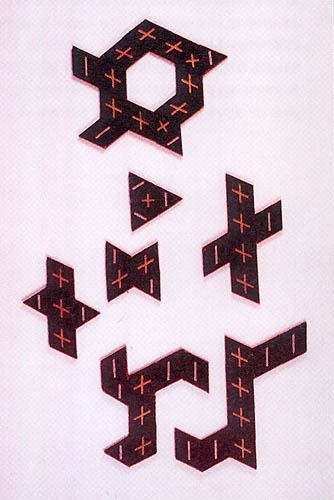previous image | Contemporary Art and Identity | next image

Kiren Budhia
Unfolding Solids, 2000
wax on canvas36" x 84"
The aim of this work is to link physics and spiritual experience as, for both, solid matter is made up of vibrating subatomic particles. The theory of unfolding geometric solid forms is used in physics to understand the bonding of subatomic particles. The practice of the eight fold noble path in Buddhism provides us with a way to observe our physical body as a subtle entity then sensations.
I have chosen the unfolding structures of molecular solid forms to represent the functioning of the subatomic particles. Color and signs are used to portray the perpetual state of change of the subatomic particles. The color red in translucent wax emphasizes flow and the mathematical symbols for addition and subtraction are used as references to electricity.
To introduce the notion of non-audible vibrational properties of subatomic particles, I have applied a listening technique. This technique is based on the principle of raga in Indian classical music. Pitch in the Indian musical system, not being absolute, can be used to describe any aspect of Reality. The combinations of notes are arranged in scales, in an aesthetic way and are given certain names. These scales have their own mood therefore they are characterized with emotions, which may vary according to time and season. There are seven basic scales, which I have juxtaposed with the subatomic particles by giving the latter names used for Indian musical notes.
|
Kiren Budhia was born in Ndola, Zambia, Africa of Hindu parents and presently lives and works in Montreal, Canada. His earlier sculptures in stone and metal explored the essence of material. Sculpture allowed him to experience "apprenticeship". Apprenticeship is not only a transfer of technique but also a "guru" system of understanding physical characteristics of all things including thoughts, feelings and perceptions. His frequent projects in India promoted a visual awareness that enable the exchange of sometimes conflicting ideas. One of these exchanges is painting. His present preoccupation is the practice of meditation and its ability to penetrate visual awareness. The mind in a state of awareness is the predominant motivation of inspiration. |
previous image | Contemporary Art and Identity | next image
